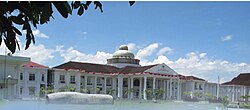Kepahiang Regency
Kabupaten Kepahiang | |
|---|---|
 Assembly House of Kepahiang Regency | |
| Motto: Sehasen | |
 Location within Bengkulu | |
| Country | |
| Province | Bengkulu |
| Regency seat | Kepahiang |
| Government | |
| • Regent | Hidayatullah Sjahid |
| Area | |
| • Total | 710.11 km2 (274.18 sq mi) |
| Highest elevation | 1,600 m (5,200 ft) |
| Lowest elevation | 250 m (820 ft) |
| Population (mid 2023 estimate)[1] | |
| • Total | 154,651 |
| • Density | 220/km2 (560/sq mi) |
| Time zone | UTC+7 (WIB) |
| Website | kepahiangkab.go.id |
Kepahiang is a regency in Bengkulu Province of Indonesia. It is located on the island of Sumatra, and was created on 25 February 2003 by splitting off the areas of the former southern districts of Rejang Lebong Regency. It covers an area of 710.11 km2, of which a high percentage (27%)[2] is still forest; thus it is the smallest (by area) of the province's regencies. It had a population of 124,865 at the 2010 Census[3] and 149,298 at the 2020 Census;[4] the official estimate as at mid 2023 was 154,651 (comprising 79,579 males and 75,072 females).[1] The regency seat is Kepahiang town. The local population consists of various ethnic groups such as the Rejang, Serawai, Javanese, Lembak and Sundanese, among which Rejang forms the majority in Kepahiang.
The Regency of Kepahiang is rich in natural resources including gold, coal, geothermal energy resources, gemstones as well as a range of agricultural, aquacultural and forest products. These include rice, oil- and coconut palms, coffee, tea, corn, wood, natural rubber and pepper, as well as various types of fruits and locally bred fish specimens and products.[5]
The local government of Kepahiang operates several development projects to achieve improvements in the sector of agriculture, energy supply and education. Some of these initiatives gained nationwide attention and were implemented by the central government in Jakarta on a national scale.[6]
Besides the formerly mentioned potentials, Kepahiang has significant tourism potential, which remains largely untapped. It is one of the official development goals to foster tourism in Kepahiang.[7]
- ^ a b Badan Pusat Statistik, Jakarta, 28 February 2024, Kabupaten Kepahiang Dalam Angka 2024 (Katalog-BPS 1102001.1708)
- ^ The Official Website of Kepahiang Regency Government: Geographical Conditions and Regional Administrations[permanent dead link]
- ^ Biro Pusat Statistik, Jakarta, 2011.
- ^ Badan Pusat Statistik, Jakarta, 2021.
- ^ "Indonesia Investment Coordination Board (BKPM), "Profil Kabupaten Kepahiang"". Archived from the original on 2014-05-05. Retrieved 2012-04-15.
- ^ Tabloid Warta Kepahiang, "Seluna Mampu Tingkatkan Ekonomi Rakyat", Kepahiang, 2011, Edition 1, p. 9
- ^ "Pariwisata dan Keunikan Lainnya". Archived from the original on 2012-05-22. Retrieved 2012-04-15.
